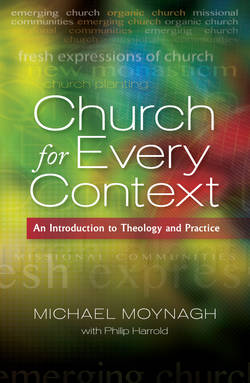Читать книгу Church for Every Context - Michael Moynagh - Страница 16
На сайте Литреса книга снята с продажи.
Missional, contextual, formational and ecclesial
ОглавлениеThe definition used here would include only a portion of the many groups and communities in the four tributaries just described. The definition is not intended to put question marks round what is left out, but to provide some discipline and coherence to the language I am using.
The emphasis on mission reflects the prevailing theological understanding that in mission the church joins God’s mission to the world.
‘Church and mission’ was once the theological frame used by the ecumenical community in an attempt to address this dynamic. It was discovered, however, that the ‘and’ already bifurcated that which was not to be divided. That is the rationale for using the adjective today, missional. (Bliese 2006, p. 239)
The definition slightly tightens the Fresh Expressions version – from communities that are ‘primarily for the benefit of people who are not yet members of any church’ to ones that ‘are birthed . . . mainly among people who do not normally attend church’. This is intended to give greater precision. It also raises the bar. Often congregations find it harder to work directly with people outside the church than to take action from a distance to support them, such as giving to charity. Yet pushing up the bar is necessary if we are to do full justice to the idea that church is missionary at its heart, a theme that is developed in Chapter 6.
The stress on contextualization (often referred to as inculturation) reflects a consensus that has emerged since Vatican II among theologians across the spectrum from Roman Catholic to evangelical. These theologians agree on the importance of contextualizing theology (and by implication the church), although their understanding of what is involved frequently differs. Stephen Bevans and Roger Schroeder (2004) have shown how historically the church’s mission has been carried out through an ongoing interaction between theological constants (basic questions that the church has always wrestled with) and a variety of changing contexts (the historical circumstances in which the basic questions are faced). A church falls down in its missional task if its witness fails to connect with its immediate setting.
Forming disciples is vital if new churches are to avoid being ‘froth expressions’ – consumerist expressions of church that fail to encourage an obligation to local people and a commitment to the whole church. ‘The ultimate test of any expression of church, whether a fresh expression or a more traditional one – is what quality of disciples are made there?’ (Cray, 2010c, p. 3).
The intention to become church marks out new contextual churches from mission initiatives or projects. The aim is not for the initiative to be a stepping stone to existing church but to encourage church to emerge within it. So the luncheon club is no longer seen as a bridge to Sunday church, but as an opportunity for the Spirit to bring church to birth within or alongside the weekly lunch. A youth initiative is not viewed as a youth club, whose members also attend church on Sunday, but as a youth congregation – as church for young people.
Frost and Hirsch have distinguished between ‘attractional’ churches that relate to the world on a ‘you come to us’ basis, and ‘incarnational’ churches that go into the surrounding context and grow new churches within it (Frost and Hirsch, 2003, pp. 41–51). The distinction is a bit sharp because there is a third – ‘engaged’ – category, which is possibly the most common type of church. ‘Engaged’ churches go into their communities in loving service, often hoping that the people they serve will be drawn into the church on Sunday (Hopkins and Breen, 2007, pp. 117–21). A project among homeless people might be set up on this basis. Many participants of course never make the journey because the gap between their everyday lives and the church is too great. Contextual churches recognize this and seek to be church in the settings of ordinary life.
‘New contextual churches’ describes communities within the four tributaries that meet these missional, contextual, formational and ecclesial criteria. They are types of church that should be encouraged for good theological reasons. However, when referring to specific initiatives, the label should be used with care. It may not be clear whether the initiative falls within the definition.
Three approaches to mission by the local church
In particular, when a community becomes church varies according to point of view. A team of Christians serving a group of people may see itself as church from the very beginning. But the people the team serves may not consider themselves to be church, and it may be a while before they view themselves in these terms. The denomination or wider institutional body will encourage the initiative as it develops, but not recognize it as a church till it appears sustainable. This of course raises questions, addressed in later chapters, about what is understood by ‘maturity’ and ‘sustainability’.
